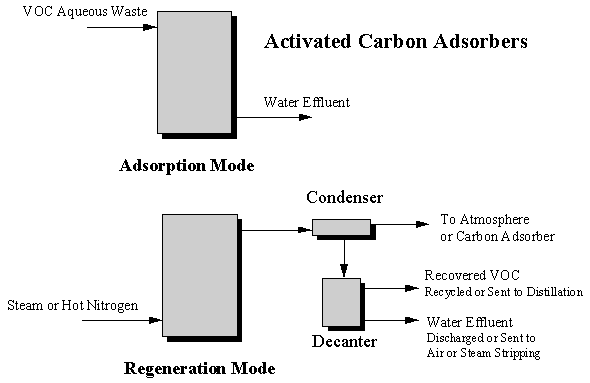Liquid-Liquid Extraction
(Belhateche, 1995; Cusack et al, 1991) |
Description
- Liquid-liquid extraction involves the separation of VOC's by contact with another liquid
(solvent) in which the VOC's are more soluble.
- Extraction solvent selection is based on:
- selectivity (ability of the solvent to extract much of the VOC but very little of the
water)
- ease of regeneration (ability to separate the VOC from the extraction solvent, typically
using distillation)
- low miscibility with the feed solution (the extraction solvent should not transfer to
the exiting wastewater stream)
- significant density difference between the extraction solvent and the wastewater feed
(aqueous and organic phases are generally separated by settling)
- moderate interfacial tension (impacts mixing capabilities)
- low viscosity (<10 cps minimizes resistance to mass transfer)
- low flammability and toxicity
- low cost and ready availability
- Separation of the solvent-VOC waste can be handled via air stripping, steam stripping,
distillation, or additional liquid-liquid extraction.
- Separation of the exiting wastewater stream can occur via air stripping, steam
stripping, activated carbon adsorption or biological treatment.
- Process efficiency can be increased by increasing the flowrate of solvent to wastewater
or by increasing the number of extraction stages.
Advantages
- Generally, liquid-liquid extraction is easy to operate.
- Capital costs are relatively low; however, if additional separation (distillation) of
exiting streams is required capital cost generally increases by a factor of 8-10 and
operating costs increase by a factor of 20.
- Can be used for heat sensitive materials.
- Can be used to separate close-boiling mixtures, such as isomers.
Disadvantages
- VOC gaseous emissions may occur from the extraction unit.
- Energy costs are high.
- Additional treatment (distillation) of streams leaving the extraction unit is generally
required.
|

